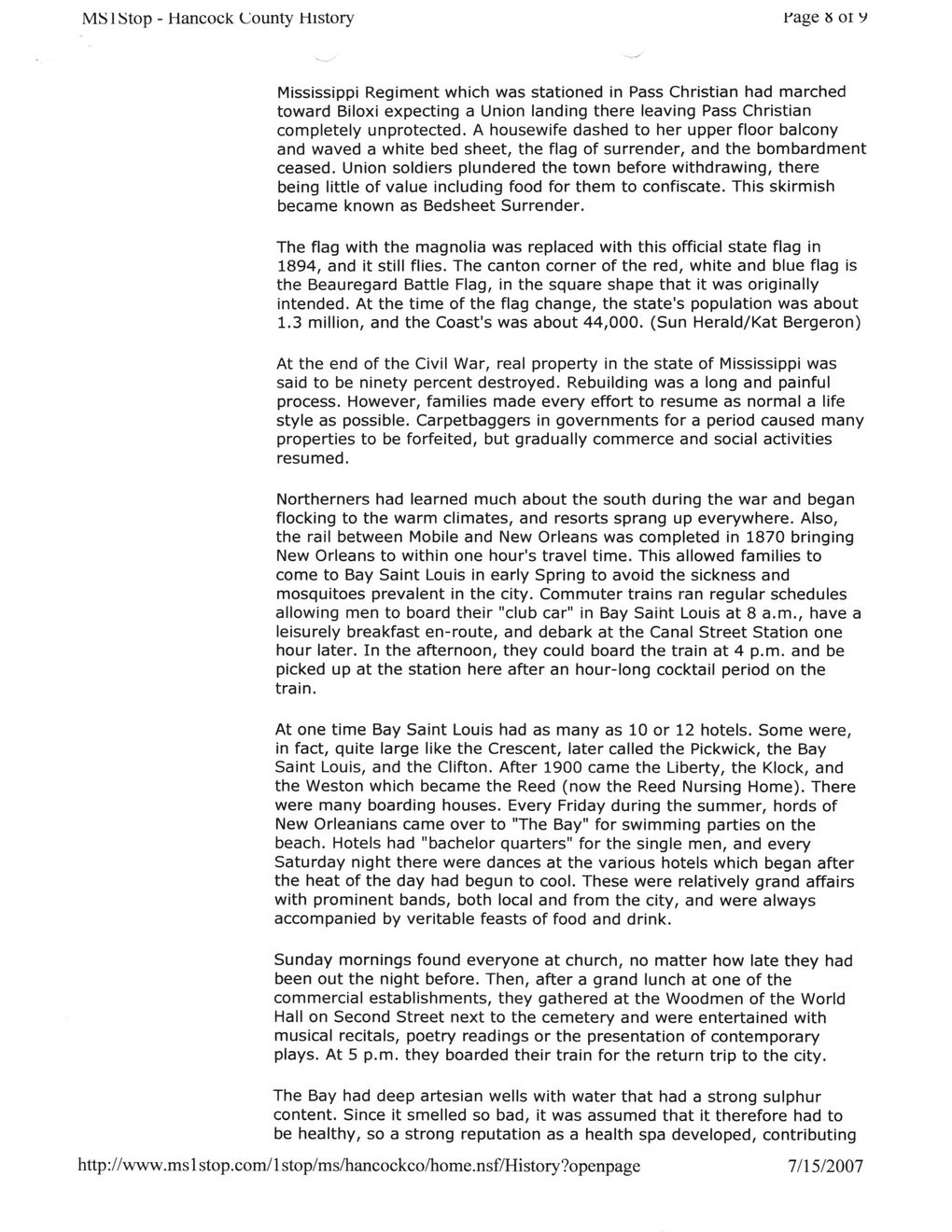This text was obtained via automated optical character recognition.
It has not been edited and may therefore contain several errors.
MS 1 Stop - Hancock County History rage 8 01 y Mississippi Regiment which was stationed in Pass Christian had marched toward Biloxi expecting a Union landing there leaving Pass Christian completely unprotected. A housewife dashed to her upper floor balcony and waved a white bed sheet, the flag of surrender, and the bombardment ceased. Union soldiers plundered the town before withdrawing, there being little of value including food for them to confiscate. This skirmish became known as Bedsheet Surrender. The flag with the magnolia was replaced with this official state flag in 1894, and it still flies. The canton corner of the red, white and blue flag is the Beauregard Battle Flag, in the square shape that it was originally intended. At the time of the flag change, the state's population was about 1.3 million, and the Coast's was about 44,000. (Sun Herald/Kat Bergeron) At the end of the Civil War, real property in the state of Mississippi was said to be ninety percent destroyed. Rebuilding was a long and painful process. However, families made every effort to resume as normal a life style as possible. Carpetbaggers in governments for a period caused many properties to be forfeited, but gradually commerce and social activities resumed. Northerners had learned much about the south during the war and began flocking to the warm climates, and resorts sprang up everywhere. Also, the rail between Mobile and New Orleans was completed in 1870 bringing New Orleans to within one hour's travel time. This allowed families to come to Bay Saint Louis in early Spring to avoid the sickness and mosquitoes prevalent in the city. Commuter trains ran regular schedules allowing men to board their "club car" in Bay Saint Louis at 8 a.m., have a leisurely breakfast en-route, and debark at the Canal Street Station one hour later. In the afternoon, they could board the train at 4 p.m. and be picked up at the station here after an hour-long cocktail period on the train. At one time Bay Saint Louis had as many as 10 or 12 hotels. Some were, in fact, quite large like the Crescent, later called the Pickwick, the Bay Saint Louis, and the Clifton. After 1900 came the Liberty, the Klock, and the Weston which became the Reed (now the Reed Nursing Home). There were many boarding houses. Every Friday during the summer, hords of New Orleanians came over to "The Bay" for swimming parties on the beach. Hotels had "bachelor quarters" for the single men, and every Saturday night there were dances at the various hotels which began after the heat of the day had begun to cool. These were relatively grand affairs with prominent bands, both local and from the city, and were always accompanied by veritable feasts of food and drink. Sunday mornings found everyone at church, no matter how late they had been out the night before. Then, after a grand lunch at one of the commercial establishments, they gathered at the Woodmen of the World Hall on Second Street next to the cemetery and were entertained with musical recitals, poetry readings or the presentation of contemporary plays. At 5 p.m. they boarded their train for the return trip to the city. The Bay had deep artesian wells with water that had a strong sulphur content. Since it smelled so bad, it was assumed that it therefore had to be healthy, so a strong reputation as a health spa developed, contributing http://www.mslstop.com/lstop/ms/hancockco/home.nsf/History7openpage 7/15/2007

Hancock County A-Touch-of-History-(8)